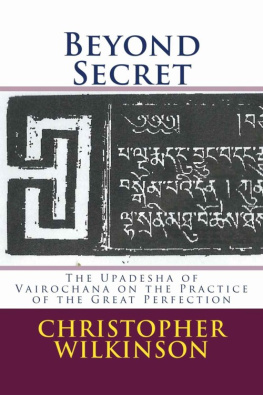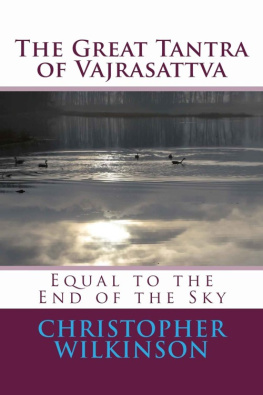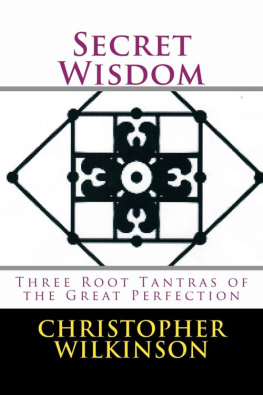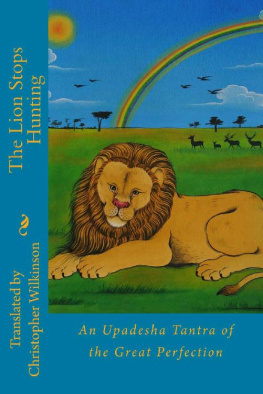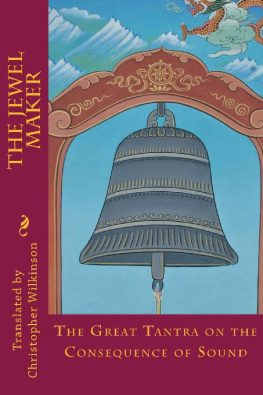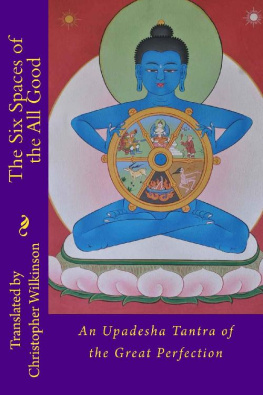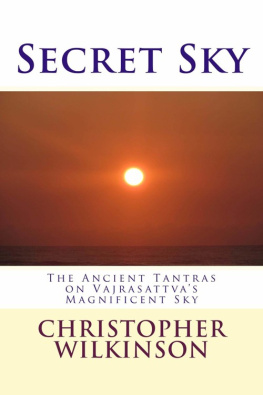No part of this book may be reproduced in any form or by any electronic or mechanical means including information storage and retrieval systems, without permission in writing from the author. The only exception is by a reviewer, who may quote excerpts in a review.
Cover Image: Detail from first page of Tibetan manuscript.
All rights reserved.
Introduction
The Changthang is a vast and desolate desert in the northern reaches of Tibet. It was on a trip to this arid region that Togden Rinpoche of Gangun, in Ladakh, was presented with a set of eight volumes, a compilation of Tantric literature connected with Vairochana Raksita, a very famous translator active in Tibet in the Eighth century of our era. In 1971 Tashi Tashigangpa published a photo-offset edition of this collection, under the title Vairoi rGyud bum , or The Hundred Thousand Tantras of Vairochana .
The Vairoi rGyud bum contains many texts that exhibit the same spelling and grammatical peculiarities we find in the Tun Huang literature, and it is reasonable that very ancient manuscripts should survive on the barren northern steppes of Tibet. It is difficult to do a careful dating of the manuscripts based on the photo-offset edition alone, but we may take it as remarkable that the manuscripts in this collection, many unique, have survived to this point.
All of the texts in these eight volumes represent Tantras that Vairochana had translated or assisted with, with the exception of a two titles: The Pan sgrub nying bcud thugs kyi nyi ma, or Sun of My Heart , which is placed at the very beginning of the entire collection, and the Bai ro dra bag , a biography of Vairochana at the end of the eighth volume. Many of the colophons in the Vairoi rgyud bum do not explicitly state that Vairochana was the translator, while many do. Sun of My Heart is not presented as a translation and there is a colophon in which the writer bequeaths the text to someone named Palkyi Yeshe, one of Vairochanas foremost disciples. So we may surmise that Sun of My Heart represents the writings of Vairochana himself, as given to Palkyi Yeshe.
Vairochana is most famous as the translator of the Five Early Translations ( sNga gyur lnga ), the historical result of his having gone to India for King Trisong Detsen (ruled from 755 to 797) in search of the Indian transmission of Sudden Enlightenment. This was during the general period during which Tibetans were highly concerned with which would prevail: The Gradual Approach represented by Kamalaila from India, or the Sudden Approach represented by Hva shang Mahayana from China, these arguments being known as the Samye Debates. It is recounted that Vairochana had some difficulties at the court of King Trisong Detsen after he had returned from India, and that he was exiled to Tsawarong.
Today, Vairochanas work may be found in this Vairoi rGyud bum and in the many compilations known collectively by the name of rNying ma rgyud bum , or Hundred Thousand Tantras of the Nyingma. Most of the works in the Vairoi rGyud bum are also found in one or more versions of the rNying ma rgyud bum , but several are not. In the case of Sun of My Heart , the manuscript found in the Vairoi rGyud bum is the only extant witness of the text.
The unique manuscript that is translated herein is written in the style of very archaic Tibetan, with vocabulary and grammatical forms similar to what we find in the dBa bzhad . The Sun of My Heart consists of a prologue and a colophon holding together six discrete commentaries on the works of the Five Early Translations and the Miraculous Occurance. Each separate chapter of Sun of My Heart was clearly a free standing work at one time. The individual titles to the six commentaries and much colophonic material have been stripped off in the present witness of the manuscript. In the case of the Magnificent Sky, some amount of material from the text itself has been lost from the end.
The index offered by Tashi Tashigangpa at the beginning of the volume presents the Sun of My Heart as going from the beginning of the volume to page 172. The text, as we have it, sets up a scene for the teachings on the six Tantras in a prologue, then there are the commentaries on the six Tantras. At the end, on page 104, there is a colophon and ending of The Sun of My Heart. The text that follows it has been stripped of its title, but on page 127 we find its full colophon, including title, author, and translator. It is immediately followed by a separate text that opens with a Sanskrit and Tibetan title. I have already documented another entry in this index that is in error due to pages missing in the manuscript. It is clear that Tashigangpas index was not done in careful detail.
For your convienance, and to help insure that this unique manuscript not fail, I include the Tibetan text as found in the photo-offset edition.
The Sun of My Heart stands as a premier contribution to contemplative literature. There is a growing understanding in the world today of the Great Perfection, and many people wish for greater knowledge of the Five Early Translations. In the present volume we have Vairochanas own descriptions on how to practice and meditate in this tradition. It is my sincere hope that you enjoy it.
Chris Wilkinson 2014
Dedication
To the memory of my teachers,
Most especially Dezhung Rinpoche,
Dilgo Kyentse Rinpoche,
Khetsun Zangpo Rinpoche,
Khenpo Palden Sherab,
Kalu Rinpoche,
And Geshe Ngawang Nornang,
As well as to
All teachers and students
Of the Great Perfection
Acknowledgements
First and foremost, I wish to thank my root teacher Dezhung Rinpoche for constantly bringing out the best in me and encouraging me to pursue a comprehension of every branch of Buddhist learning. It was he who introduced me to Dilgo Kyentse Rinpoche, and through his recommendations enabled me to receive full empowerments, transmissions, and permissions in the areas of Mah, Anu, and Ati Yogas. With the highest regard I wish to thank Dilgo Kyentse Rinpoche, Khetsun Zangpo Rinpoche, and Khenpo Palden Sherab for their kind instruction and encouragement in my effort to translate the literature of the rDzogs chen. There are many individuals, too many to name here, that have helped me over the years to become a qualified translator, in many ways. At this time I want to remember the kindness of Ngawang Kunga Trinlay Sakyapa, Dhongthog Rinpoche, H.H. Karmapa Rangjung Rigpay Dorje, Kalu Rinpoche, Chogyam Trungpa Rinpoche, Geshe Ngawang Nornang, David Ruegg, Turrell Wylie, Gene Smith, Karen Lang, Anne MacDonald, Richard Solomon, Jack Hawley, David Jackson, Cyrus Stearns, Herbert Guenther, Eva Neumeier-Dargyay, Leslie Kawamura, Robert Thurman, Paul Nietupski, Lou Lancaster, David Snellgrove, Jean-Luc Achard, Steve Landsberg, Moke Mokotoff, Tsultrim Alione, Carolyn Klein, Rob Mayer, Jonathan Silk, David White, Mark Tatz, Steve Goodman, and Kennard Lipman. The many people who have contributed to my understanding and ability to do this work cannot be counted. I wish to thank everyone that has taken a kind interest in these translations, however slight, for your part in making this work a reality.

